-
Posts
2,480 -
Joined
-
Last visited
Content Type
Profiles
Forums
Gallery
Events
Posts posted by JSGerson
-
-
- Martin W, CaptainSteve and GuntherMT
-
 3
3
-
Chuck Passaro’s Syren Ship Model Company makes very nice laser-cut plastic hooks of various sizes. Unfortunately the physical hook of his smallest version will not pass through the hole I created when I made my futtock plates. That meant I had to make my own.
First I tried some aluminum wire I had for the color – too thick. Then I tried some very fine brass wire and got a beautiful hook. Too bad the wire was so pliable, a simple tug and the hook would straighten out and fall off. I didn’t dare attempt to heat temper it for fear of burning it up – too weak.
- CaptainSteve and Martin W
-
 2
2
-
Futtock Shrouds
The futtock shrouds is connected to the futtock plates above via a hook and lashed to the shrouds below. Normally the metal hook connects to a metal thimble seized on the end of the futtock shroud. Due to the difficulty of constructing a thimble at this scale and the ability to even see it even if it were there, I have elected not to create these thimbles. The diagram below is from Rigging Period Ship Models, by Lennarth Petersson.
- CaptainSteve, GuntherMT and Martin W
-
 3
3
-
Now that I see more of the model I recognized it as a 1797 version built by Mark Antczak at 1:48 scale. The site is at.shipmodel.com
-
GLakie - Are there more images the "72" version of the 1797 config."? I'm always looking for more sources to use when I finally start my attempt at the MS Constitution model. That probably won't be be for a year or two at the rate I building the Mamoli Rattlesnake. Is that model yours? It looks gorgeous.
-
-
-
That's the way I did it, I had all the finesse of a blind drunken sailor with hiccups.
If I knew how to do this easily, I would lock the Dremel horizontally so that the spinning disc would be downward at the point cutting. Then mount the razor blade flat on a notched piece of wood for solid support with the razor's edge flush with the wood piece's edge. The notch is where the cutting disc would engage the razor. Finally mount the razor and notch wood platform on an X-Y Table for absolute precise movement.
Jon
-
Yes, I had to buy the package of mandrels as well. Those don't break so I (and probably you as well) now have a lifetime supply of mandrels. As for the discs, well...At least the razor blades are cheap. I didn't know about using hacksaw blades as an alternative. Even if I did, I didn't have any new or old ones to use. Once the scraper was made, it held up rather well although my technique of using it could have used some improvement. I did not have to replace it due to breakage or wearing out.
What method of cutting the profile did you use?
You may have notice if you have read further into my log, that I tried not using scrapers if I could get away with it. I just found the scraper tedious so I tried to be a little imaginative with my Dremel drill press which I detailed in the log. Let me state now that I am not a fan of the Dremel drill press. I find it too loose and imprecise. It is plastic after all, but that was and still is all I have. One of these days I'll get a real milling machine.
Jon
-
In Bob Hunt practicum he points you to a company that makes very fine cutting wheels. I bought some and they cut through razor blades like butter, but they are very delicate. Breathe on them wrong and they will shatter. From other sources, people like to use old hack saw blades in lieu of razors for its rigidity. The real trick is figuring a way to manipulate the scraper so that you can cut the profile. Do you hold the blade against a fixed position spinning cutter or move the cutter while the blade is held fixed? The choice is yours.
It is very important that you wear eye protection. You don't want metal shards or broken cutting discs pieces in your eye. Because I am very farsighted and wear tri-focals, I need a clip-on 3X eye loupe as well and have to get within inches of the cutting blade to see what I am doing. Then I had to make numerous trial cuts till I got something halfway decent.
Once you've created the scraper, clamp it in a vise...tight. Use a piece of wood that is longer than you need and fits exactly to the width of the scraper's profile cut you made. Draw the wood strip repeatedly through the scraper.
Jon
-
-
You lucky stiff! I met Chuck at the last NRG Conference in St. Louis when he demonstrated how he makes his wonderful miniature rope. What surprised most of us who witnessed the demonstration, was that he used the simple Model Expo wooden rope walk (as opposed to the Byrnes precision machined rope walk). He did modify it so that it accepts an electric drill to power it instead of a hand crank. He was willing to answer any and all questions and talk with you. Awfully nice guy.
Unfortunately for me, there is no modelling club near me to help me along.
Jon
-
How did you even know to order the capstan kit if Chuck hasn't yet built one himself let alone advertise it?
Jon
-
Ahh, that makes more sense. Didn't think to check if Harold Hahn had USS Constitution Plans. I have his Rattlesnake plans.
-
Blue Pilot - I too plan on building the Connie and also have the Hunt Practicum, the US Naval History Heritage CD, and a ton of images of the ship, but what are the Hawnn Plan?
-
-
Martin - I did actual use paper clip gauges although you wouldn't know it from my results. I did everything you described...almost. The problem was that I liked seizing the deadeyes on my sizing machine. I could make them nice and tight. I would seize the first deadeye on the machine. Then holding it in place with the gauge on the model, loop the shroud over the mast to the other deadeye also attached to a gauge. A clip was placed on the looped 2nd deadeye to hold the shroud in position. Here is were it got squirrely. I removed the shroud from the model and seized the second end on the machine. I imagine due to the variances in tension, how it looped over the mast the second time in comparison to the first time, placing it on the seizing machine, etc. when finally installing the shroud, things didn't line up as intended. The deadeyes were all seized and glued at this point so I ended up with what I had. I did the best I could with the lashings.
My original concern was I could not seize the shrouds insitu on the model and make it clean and tight. Well I got got clean and tight, but uneven deadeyes. I'll try your method on the next mast step.
Jon
-
If I had thought about printing the name like you did, I don't know if I would have done the lettering the way I did (on a plaque). Either way works. Nice job on the capstan.
Jon
-
Your transom is coming along just fine.
I had a lot of plans for the transom, and had to compromise on just about all of them.
Welcome to the club. I had all kinds of problems with the back end of the model and had to get creative in order to get the ship's name on her. Yours came very nice. Can I assume you used dry transfer lettering?
Your window frames look great also. Can you provide any detail as to how you accomplished it?
-
I just discovered your "new" build log today. New for me but you've started it back in March. I was wondering if you were aware of the work of Gene Bodnar at Model Ship Builder who built not one, but three cross sections of the Connie (1:32 scale) which could be put together to form the complete hull? If not take a look at his build log.
BTW nice work on this build too.
-
Once I was satisfied all was right with the world, a drop of CA glue was applied to each knot and the excess lines cut off, not with a scissors, but with a sharp X-acto knife to get as close to the knot as possible. It may not be the best ratline ever done, but hopefully it’s not too bad for my first.
-
-
Ratlines
All the staves were installed under the tops and above the deadeyes. The ones above the deadeyes gave me pause. Due to lack of my skill and/or experience the deadeyes did not line up was well as I had hoped. I was consoled somewhat because I had read somewhere that they did not always lined up due to the need to be adjusted due to wind conditions, moisture, etc. which affect their tautness. Therefore I attempted to minimize the obviousness of their irregularity by installing the lower staves a little higher above the deadeyes. After taking two weeks off from model building to visit Mom in Florida (she turns 97 next week) I returned home and realized that after looking at the model afresh, I could have lowered them a bit more but they were glued into place. Be that as it may, I plodded on. Per Mr. Antscherl’s instructions I started to install the ratlines using my thinnest cotton thread. Using an index card with the proper spacing of the ratlines laid out, I installed a line every third row without any glue so as to maintain the shrouds vertical straightness. A simple knot was used on the outside shrouds and Clove Hitch knots were used on the interior shrouds. Because they were not glued at this point, final line adjustments could be made.
- CaptainSteve and Martin W
-
 2
2
-
Very nicely done. You are a better man than me. I'll be very happy just to get the standing rigging in place. Just out of curiosity since I won't be adding sails to my model, what kind of sail cloth are you using and why?




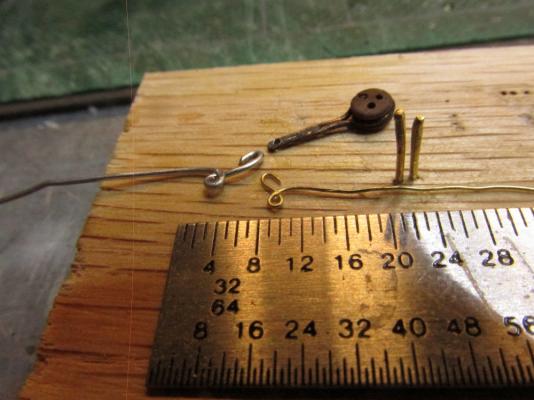
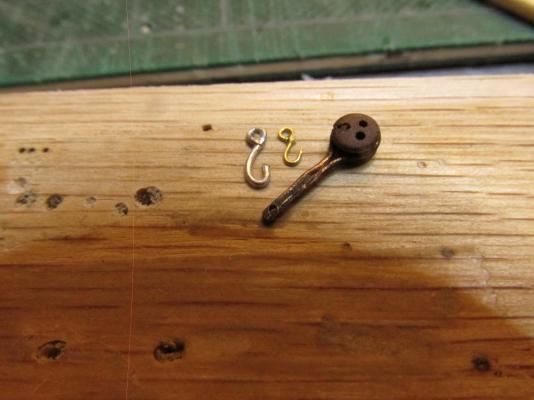
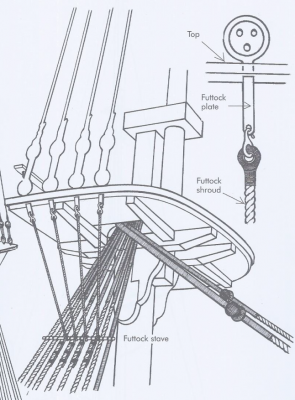
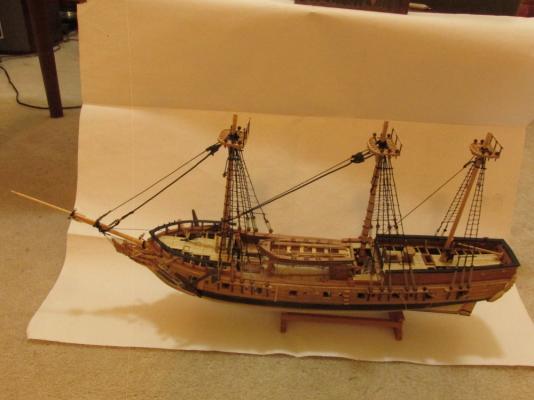
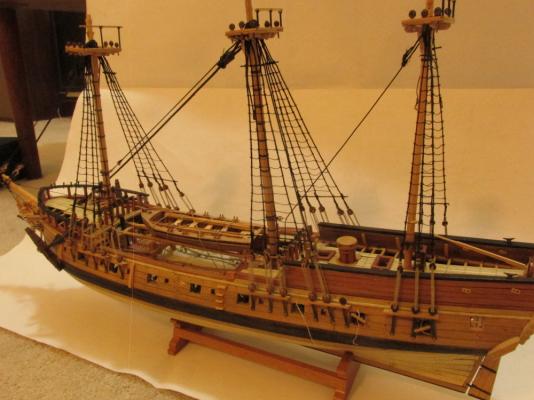
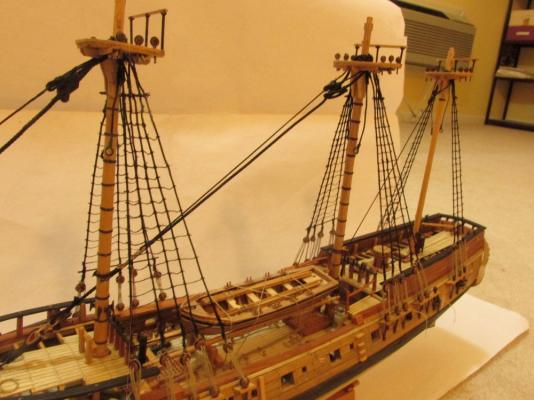
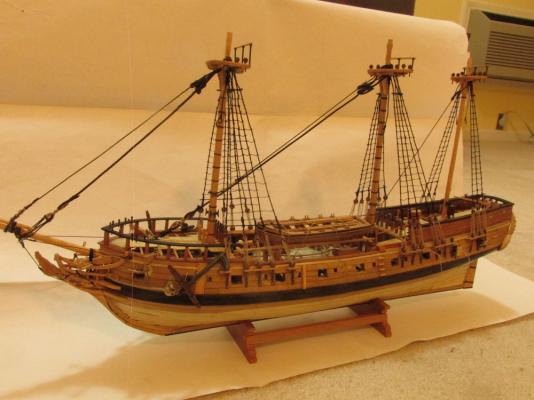
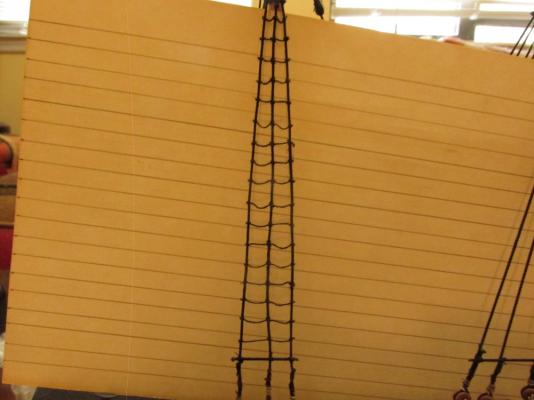
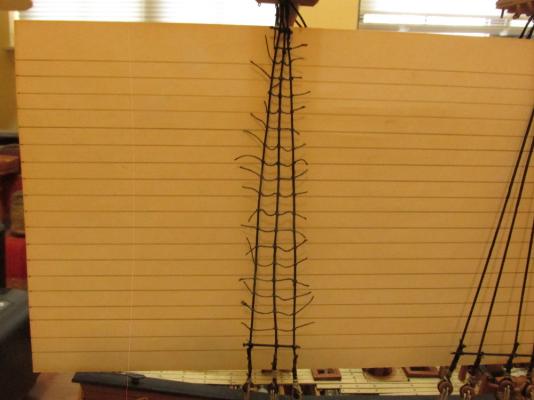
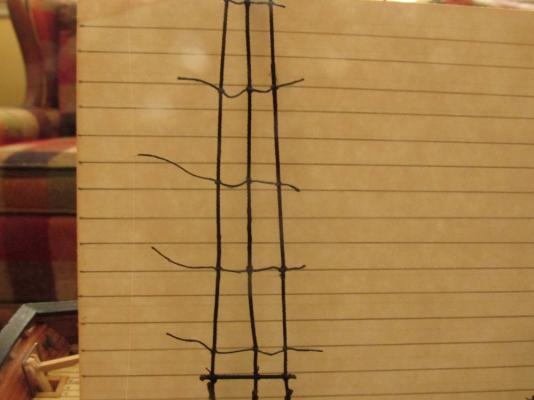
Rattlesnake by JSGerson - FINISHED - Mamoli - 1:64 - Using Robert Hunt’s practicum
in - Kit build logs for subjects built from 1751 - 1800
Posted
The hook was made by first opening up the eyelet and then wrapping it around two tiny nails used for planking to create the shape which you can see in the first picture. After the excess wire was trimmed off, the hook then was squeezed with a pair smooth jaw plyers to flatten it and then filed smooth.